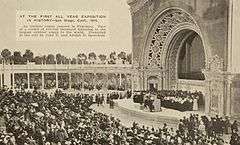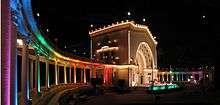Spreckels Organ Pavilion
Spreckels Organ Pavilion houses the open-air Spreckels Organ in Balboa Park, San Diego, California. The Spreckels Organ is the world's largest pipe organ in a fully outdoor venue. Constructed for the 1915 Panama-California Exposition, it is located at the corner of President's Way and Pan American Road East in the park.
| Spreckels Organ Pavilion | |
|---|---|
 Organ concert at the pavilion, February 1915 | |

| |
| General information | |
| Type | Pipe organ |
| Location | Balboa Park, San Diego, California |
| Address | 1549 El Prado #10 San Diego, CA 92101 |
| Construction started | 1914 |
| Completed | 1914 |
| Opened | December 31, 1914 |
| Cost | Organ: $33,500 ($855,085 today) Pavilion: $66,500 ($1,697,407 today) |
| Height | 75 feet (23 m) |
| Design and construction | |
| Architect | Harrison Albright |
| Main contractor | Wurster Construction Company |
| Other information | |
| Seating type | Metal benches |
| Seating capacity | 2,500 |
| Website | |
| http://spreckelsorgan.org/ | |
History
John D. Spreckels, son of sugar magnate Claus Spreckels, was one of the wealthiest residents in San Diego County. He supported the Panama-California Exposition, and during its construction, he and his brother Adolph B. Spreckels gave the organ pavilion as a gift to "the people of San Diego" and "the people of all the world" on December 31, 1914.[1] They donated $33,500 ($855,085 today) for the organ and $66,500 ($1,697,407 today) for the pavilion.[1] After Spreckels' announcement, a local orchestra performed Jacques Offenbach's Orpheus in the Underworld which was then followed by a 250-person chorus that sang pieces from Joseph Haydn's oratorio, The Creation.[2]
On July 27, 1915, former president Theodore Roosevelt gave a speech at the organ pavilion in front of nearly 19,000 people. He touched on topics about world peace and his desire for the United States to maintain a minimum of 200,000 military members.[3] He also requested that San Diegans permanently keep the temporary buildings set up for the exposition.[4] Former president William Howard Taft also spoke at the pavilion to over 7,000 people on September 16, 1915. Taft commended the city on the architecture used for the exposition buildings.[5]
John D. Spreckels also donated the services of renowned organist Humphrey John Stewart for the two-year run of the exposition. After the exposition, Spreckels extended Stewart's contract. When Spreckels died in 1926, the pavilion was used for his memorial service.[6]
The U.S. Navy borrowed Balboa Park during World War II, and no organ concerts were played during 1942–1948.[7] During the 1970s and 1980s, the pavilion fell into disuse and risked being demolished. Around $1.1 million was raised for repairs by the early 1980s from the city and a local non-profit.[7]
Design
Initially, Bertram Goodhue's plans for Balboa Park for the Panama-California Exposition included a music pavilion that would be located north of Plaza de Panama.[8] After Brazil decided not to participate with a building in the exposition, the pavilion was built at its site instead.[8] Spreckels chose Harrison Albright to design the organ pavilion. Albright was a self-taught Los Angeles architect, who previously designed the U.S. Grant Hotel in downtown San Diego. The semi-circular pavilion was built by the F. Wurster Construction Company in an ornate Italian-Renaissance design. The organ was built by Austin Organs, Inc. as their Opus #453. It has 80 ranks totaling 5,017 pipes and faces north to protect the pipes from the sunlight. The audience therefore faces south. Commercial airplane landings at San Diego International Airport occasionally compete with the organ's sound.[9]
During the 1935 California Pacific International Exposition, the stage size was doubled and a fountain added.[1] The fountain can be lit at night and is modeled after one in Chapultepec Park in Mexico City.[1] In 1981 the pavilion was restored, and in 2002 the organ was expanded from 3,400 to 4,518 pipes. In 2015, the organ was expanded to 80 ranks and 5,017 pipes. San Diego's Spreckels Organ is now the world's largest pipe organ in a fully outdoor venue, although western New York has the larger Massey Memorial Organ in an open-air auditorium with a roof.[9]
Concerts and events
Free organ concerts are given at 2:00 p.m. each Sunday afternoon, sponsored by San Diego Parks and Recreation Department, the Spreckels Organ Society and private donations.[10] On Monday evenings in the summer, The Spreckels Summer International Organ Festival is also presented by the Spreckels Organ Society. During the summer on Tuesdays, Wednesdays, and Thursdays, "Twilight in the Park" provides mixed popular concerts. The annual December Nights celebration is performed on the Spreckels stage.[11] The San Diego Community Christmas Center displays nativity scenes in the Pavilion during the Christmas season.[12]
On August 31, 2014, Drive Like Jehu reunited for a performance at the pavilion, accompanied by Civic Organist Carol Williams. The collaboration was facilitated by the Spreckels Organ Society board of directors. The novelty of playing with the accompaniment of the organ was a key factor in bringing the band back together.[13]
Civic Organists of San Diego


- Humphrey John Stewart 1914–1932
- Royal Albert Brown 1932–1954
- Charles Rollins Shatto 1954–1957
- Douglas Ian Duncan 1957–1978
- Jared Jacobsen 1978–1984
- Robert Plimpton 1984–2001
- Carol Williams 2001–2016[14]
- Raúl Prieto Ramírez 2018–[15]
Organ Curators
- Edward Crome 1914 (Installer)
- Anton Rokos 1914–1916 (Curator & Installer)
- Roy W. Tolchard 1916–1932
- Edwin A. Spencer 1932–1947
- Leonard L. Dowling 1947–1974
- Lyle Blackinton 1974–present[9]
References
- Citations
- Amero, Richard. "The Spreckels Organ Pavilion in Balboa Park". San Diego History Center. Archived from the original on November 17, 2014.CS1 maint: unfit url (link)
- Amero (2013), p. 51
- Amero (2013), p. 93
- Pourade (1965), p. 197
- Amero (2013), p. 99
- Christman (1985), p. 74
- Steele, Jeanette (December 31, 2004). "At 90, the Spreckels pipes are fine". UT San Diego. Archived from the original on November 17, 2014.CS1 maint: unfit url (link)
- Amero (2013), p. 45
- Whitney, Craig R. (April 28, 2007). "With Jets Providing Accompaniment, a Rare City Treasure Stands Exposed". The New York Times. Archived from the original on November 17, 2014.
- Alagot, Calvin; Forgione, Mary; Hamm, Catharine; Harnagel, Anne & Reynolds, Christopher (March 10, 2019). "A guide to the San Diego sites that make it unlike any other". Los Angeles Times. Retrieved 11 March 2018.
- Figuracion, Inigo. "Balboa Park's December Nights 2012". About Travel. Retrieved November 16, 2014.
- "San Diego Community Christmas Center - About Us". Retrieved 2019-12-29.
- Varga, George (August 19, 2014). "Drive Like Jehu Reunites After 19 years". U-T San Diego. Archived from the original on November 22, 2014.
- "Spreckels Organ Pavilion". Balboa Park. Retrieved November 16, 2014.
- "Spain's Raúl Prieto Ramírez hired as new San Diego civic organist". San Diego Union Tribune. Retrieved January 8, 2018.
- Bibliography
- Amero, Richard W. (2013). Balboa Park and the 1915 Exposition (1st ed.). Charleston, South Carolina: The History Press. ISBN 1-626193-45-2.
- Christman, Florence (1985). The Romance of Balboa Park (4th ed.). San Diego: San Diego Historical Society. ISBN 0-91874-003-7.
- Pourade, Richard F. (1965). Gold in the Sun (1st ed.). San Diego: The Union-Tribune Publishing Company. ISBN 0-913938-04-1.
External links
| Wikimedia Commons has media related to Spreckels Organ Pavilion. |
- "Spreckels Organ Society" Contains concert schedule information
- "Spreckels Organ Pavilion" (San Diego Park and Recreation Department)
- The Spreckels Pipe Organ specifications